Jimi Hendrix. The name itself conjures images of revolutionary sounds and a groundbreaking approach to the electric guitar. While his Fender Stratocaster is iconic, limiting Hendrix to just one instrument type would be a disservice to his expansive sonic palette. Hendrix, a true innovator, explored a vast landscape of guitars, each contributing to his legendary sound. Beyond the Strat, his journey involved a fascinating array of instruments, from budget-friendly models to Gibson classics and unique oddities.
Let’s embark on a chronological exploration of Jimi Hendrix’s guitars, charting the instruments that played pivotal roles in his career and became intertwined with rock and roll history. This is not an exhaustive catalog, but a focused look at the guitars that truly defined the sound and image of Jimi Hendrix, with a special emphasis on his beloved Stratocasters.
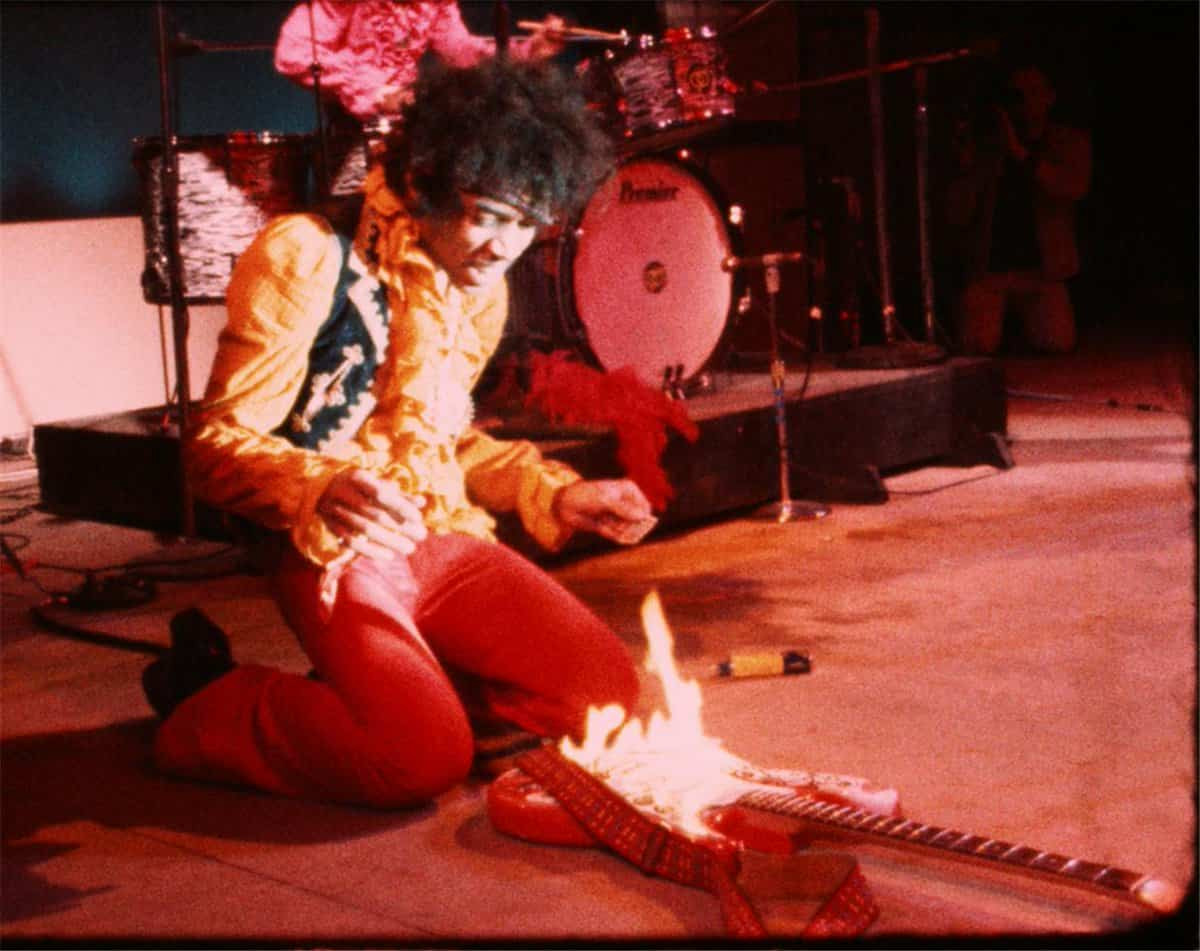 Jimi burning his Strat at the Monterey Pop Festival, 1967
Jimi burning his Strat at the Monterey Pop Festival, 1967
The Reign of the Stratocaster: Jimi Hendrix and His Fender Strat Guitars
While Jimi Hendrix experimented with various guitars, the Fender Stratocaster became his signature weapon of choice. From early, budget-friendly models to iconic, stage-burnt instruments, the Stratocaster was central to his groundbreaking sound. Here’s a closer look at some of the most significant Stratocasters in Jimi Hendrix’s guitar arsenal.
“Carol” – 1960 Fender Stratocaster: The Genesis of a Stratocaster Love Affair
The “Carol” Stratocaster, a 1960s model, likely marks the inception of Hendrix’s enduring relationship with the Stratocaster. Purchased in New York City by his girlfriend Carol, this guitar preceded his transformative journey to the UK in 1966. In its original state, this Stratocaster was stock, with the simple yet crucial modification of restringing for Jimi’s left-handed playing style.
The subsequent history of “Carol” remains shrouded in mystery. It wasn’t the white Stratocaster he brought to the UK, suggesting its use was primarily in the US before his international breakthrough. Rumors of its destruction at a show persist, though given Hendrix’s financial constraints at the time, this seems improbable.
“Linda” – 1964 Fender Stratocaster: The White Strat that Conquered Britain
In 1966, a chance encounter with Linda Keith, then-girlfriend of Keith Richards, proved pivotal. Recognizing Hendrix’s talent, Linda lent him her white 1964 Fender Stratocaster, affectionately nicknamed “Linda,” from Keith Richards’ collection.
“Linda” became the sole guitar Hendrix carried to the UK in 1966, becoming his primary instrument for performances throughout that year, including notable TV appearances in December. It’s highly probable that the iconic track “Hey Joe” was recorded using this very guitar. Like most of Hendrix’s Stratocasters, “Linda” remained unmodified. Sadly, this piece of guitar history vanished in 1967, stolen and never recovered.
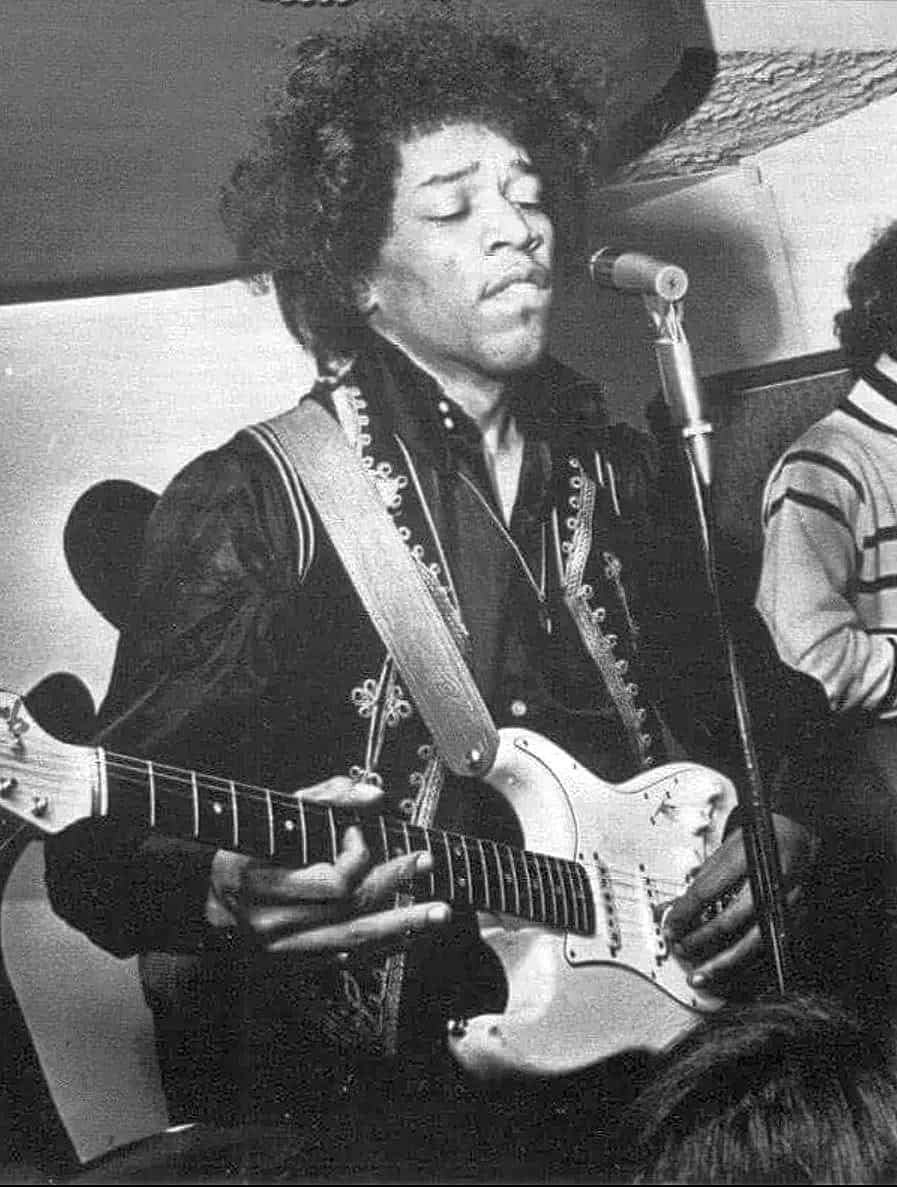 Jimi playing "Linda." Credit: Freddie Mudditt of Fietscher Fotos Ltd
Jimi playing "Linda." Credit: Freddie Mudditt of Fietscher Fotos Ltd
“Zappa” – 1960s Fender Stratocaster: The Scorched Enigma
The “Zappa” Stratocaster, a 1960s model bearing the scars of fire, is one of the most debated and iconic guitars associated with Jimi Hendrix. Later owned by Frank Zappa and subsequently his son Dweezil, its story is filled with intriguing discrepancies.
Frank Zappa claimed to have acquired the burnt Stratocaster from Hendrix’s roadie, Howard Parker, in 1968, alleging it was ceremonially torched at the Miami Pop Festival. However, accounts from multiple witnesses contradict this, stating Hendrix did not burn a guitar at Miami Pop. Yet, the guitar’s charred condition is undeniable.
The prevailing theory suggests this guitar might be the Stratocaster Hendrix set ablaze at the Astoria Theatre in Lancashire, England. Scratches and wear patterns on the guitar’s body align with photographic evidence of the Astoria Stratocaster. The unanswered questions surrounding “Zappa”—how Parker obtained it, its journey from London to the US, and why Hendrix would keep a burnt guitar—only amplify its enigmatic allure.
 A 1977 issue of Guitar Player featuring Frank Zappa and Hendrix's scorched black Strat. Credit: Guitar Player Magazine
A 1977 issue of Guitar Player featuring Frank Zappa and Hendrix's scorched black Strat. Credit: Guitar Player Magazine
Monterey Pop Stratocaster – 1963/64 Fender Stratocaster: Ritualistic Pyre at a Cultural Crossroads
The 1963 or 1964 Fender Stratocaster immolated at the Monterey Pop Festival is arguably the most famous Jimi Hendrix Guitar. Acquired in early 1967, its documented debut was on Top of the Pops in March of that year. Originally red with a rosewood fretboard, a departure from his preferred maple necks, it was later adorned with its psychedelic paint job in 1967.
This vibrantly decorated Stratocaster met its fiery end at Monterey Pop after Hendrix’s performance of “Wild Thing.” Following the conflagration, Hendrix smashed the remains, a piece of which is now enshrined at the Museum of Pop Culture in Seattle. Despite its brief period of use, the Monterey Stratocaster’s iconic status has inspired Fender to release multiple Monterey Strat models, forever cementing its place in guitar history.
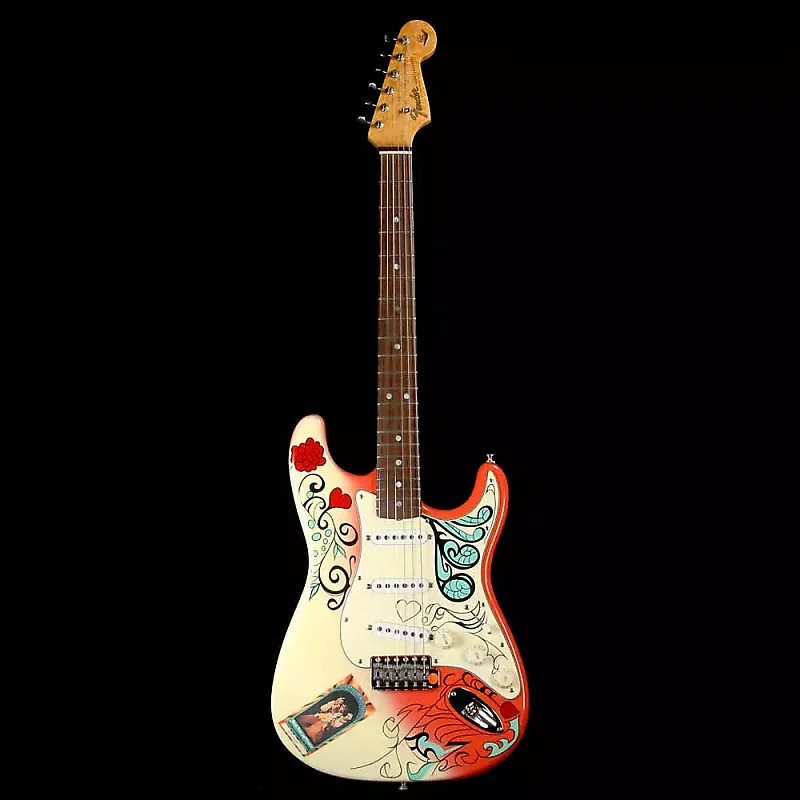 A Fender Custom Shop Jimi Hendrix Monterey Stratocaster. Credit: Fender.com
A Fender Custom Shop Jimi Hendrix Monterey Stratocaster. Credit: Fender.com
Monterey Black Stratocaster – 1965/66 Fender Stratocaster: The Survivor of Monterey
In contrast to its fiery counterpart, the 1965/66 Black Stratocaster emerged unscathed from the Monterey Pop Festival. This guitar appears to have been a favorite of Hendrix during 1967, used extensively throughout the Monterey Pop performance and subsequently at the Fillmore West and Whiskey a Go-Go.
While unconfirmed, it’s speculated that this Black Stratocaster was the guitar Hendrix burned at the Ambassador Theater in Washington, D.C., marking the last known instance of him setting a guitar ablaze on stage. Afterward, the guitar was reportedly smashed, and Hendrix signed and distributed pieces to venue staff. In 2012, a guitar purported to be this Monterey Black Stratocaster surfaced for sale, but its authenticity has been widely questioned, as detailed in this video from CGS.
Modified 1960s Fender Stratocaster: A Foray into Pickup Switching
A unique Stratocaster in Jimi Hendrix’s collection was a modified 1960s model, observed in use only a few times in 1967. Its defining feature was a customized pickup switch system featuring three independent toggles instead of the standard five-way switch. This alteration allowed for a wider array of pickup combinations, enabling each pickup to be individually activated or deactivated.
Hendrix’s limited use of this modified Stratocaster suggests he may not have favored the alteration. Its current whereabouts are unknown. It’s plausible the modified pickguard was replaced with a standard Stratocaster configuration, and Hendrix resumed playing it in its original form, but this remains speculative.
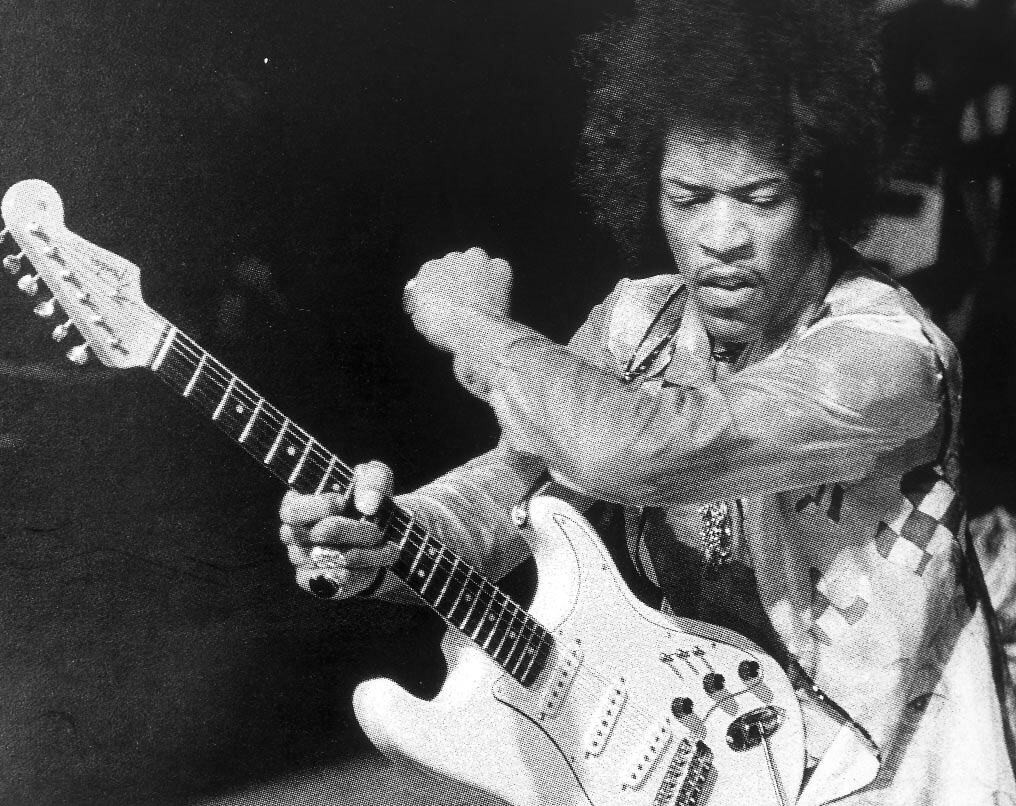 Jimi playing the modified Stratocaster in 1967. Photo source: GitarreBass.de
Jimi playing the modified Stratocaster in 1967. Photo source: GitarreBass.de
White 1967 Fender Stratocaster: The Electric Ladyland Studio Companion
The white 1967 Fender Stratocaster was a mainstay for Hendrix throughout most of 1968, seemingly holding a special place in his guitar collection. This guitar was used at significant performances like Miami Pop and the Fillmore East in 1968, among numerous other shows.
This white Stratocaster is also one of the most documented Jimi Hendrix guitars, particularly for its role in the recording of much of Electric Ladyland. Eddie Kramer, the album’s engineer, specifically recalled Hendrix using a white Stratocaster for the recording of “Voodoo Chile,” very likely this instrument.
Woodstock Stratocaster – 1968 Fender Stratocaster: An Anthem for a Generation
Hendrix’s performance at Woodstock in 1969 is legendary, and the 1968 Stratocaster he wielded that day has become perhaps the most iconic of all Jimi Hendrix guitars. Acquired in 1968, this Stratocaster remained stock and was used regularly by Hendrix leading up to the Woodstock festival.
In 1970, Hendrix gifted this historically significant guitar to Experience drummer Mitch Mitchell. Mitchell retained it until 1991 when it was sold to an Italian TV host and music critic. It was subsequently acquired by Microsoft co-founder Paul Allen, who enshrined it in the Museum of Pop Culture in Seattle, where it remains a centerpiece of music history.
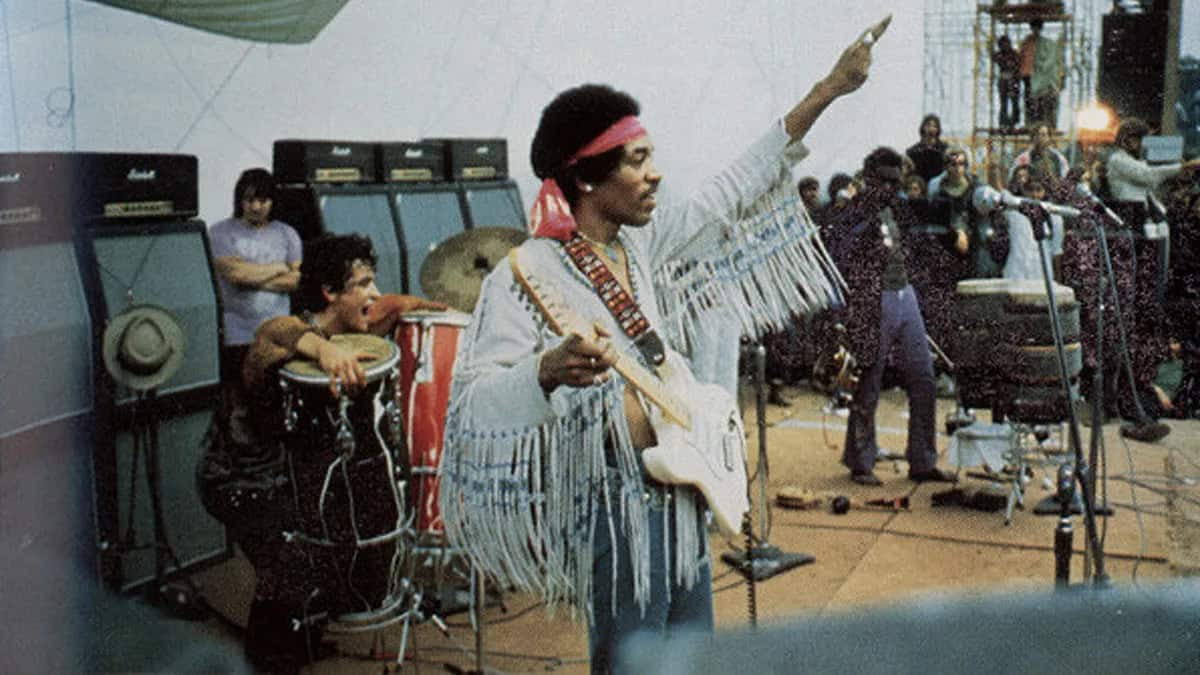 Hendrix at Woodstock. Source: *Woodstock: The Movie*
Hendrix at Woodstock. Source: *Woodstock: The Movie*
Newport Stratocaster – 1960s Fender Stratocaster: The Telecaster Neck Hybrid
The Newport Stratocaster stands apart from all other Jimi Hendrix Stratocasters due to one striking modification: a Telecaster neck. Hendrix used this unique hybrid at only two known performances, one of which was the Newport Folk Festival.
Luthier Neal Moser claims to have repaired this guitar for Hendrix, installing the Telecaster neck as a replacement when a Stratocaster neck was unavailable. Faced with a broken neck and an impending show, the resourceful solution resulted in the birth of the distinctive Newport Stratocaster.
Beyond the Strat: Jimi Hendrix’s Guitar Outliers and Rarities
While synonymous with the Stratocaster, Jimi Hendrix’s guitar explorations extended far beyond Fender’s flagship model. Let’s examine some of the outlier guitars that ventured outside his Stratocaster preference, adding unique textures to his sound.
1961 Epiphone Wilshire: Nashville Beginnings
During his time in Nashville in 1962, Jimi Hendrix, alongside Billy Cox, formed the band The King Casuals. His primary guitar during this period was a 1961 Epiphone Wilshire. Despite his relative obscurity at the time, the Wilshire has become retrospectively associated with Hendrix’s early career.
This particular Wilshire likely underwent modifications, potentially by Jimi or a previous owner. The enlarged 17th fret inlay, possibly a sticker, and the addition of a tremolo system, which was not a standard feature on 1961 Wilshires, suggest alterations from its original factory configuration.
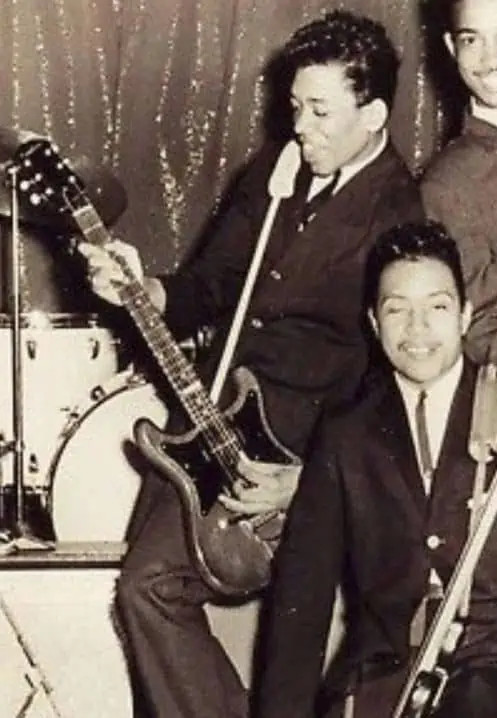 A young Jimi playing his Epiphone Wilshire.
A young Jimi playing his Epiphone Wilshire.
1967 Hand-Painted Gibson Flying V: Art on Six Strings
Jimi Hendrix’s 1967 hand-painted Gibson Flying V, though used briefly, is an instantly recognizable guitar thanks to its vibrant custom artwork. Purchased in the summer of 1967, it became one of his main stage guitars until early 1968. Beyond its striking visual modifications, the guitar itself remained a stock Flying V.
Rumors persist about Hendrix using the Flying V on Electric Ladyland, particularly on “All Along the Watchtower,” but these claims remain unconfirmed. However, its presence as a stage guitar throughout 1967 and early 1968 is well-documented.
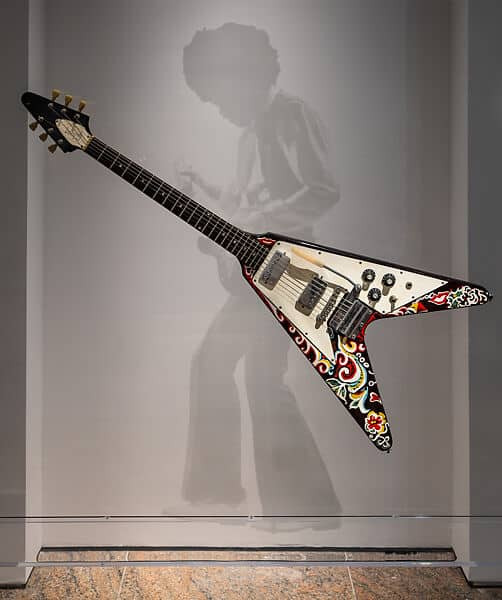 Jimi's painted Gibson Flying V at the Metropolitan Museum of Art. Credit: Metropolitan Museum of Art.
Jimi's painted Gibson Flying V at the Metropolitan Museum of Art. Credit: Metropolitan Museum of Art.
Mosrite Joe Maphis 12/6 Doubleneck: Sonic Textures of “Spanish Castle Magic”
The Mosrite Joe Maphis 12/6 doubleneck guitar occupies a unique niche in Jimi Hendrix’s arsenal, famously used to record “Spanish Castle Magic” from Bold as Love. Accounts differ regarding how Hendrix acquired this unusual instrument. Some sources claim he purchased it from a New York City shop, while Dana Moseley, daughter of Mosrite founder Semie Moseley, recalls Hendrix personally picking it up at the Mosrite factory.
Regardless of its acquisition story, this doubleneck Mosrite, though not among his most iconic guitars, played a crucial role in shaping the sound of one of his most beloved songs, highlighting his willingness to explore diverse sonic textures.
1965 Fender Sunburst Jazzmaster: A Sidestep into Offset Territory
A 1965 Fender Sunburst Jazzmaster makes a fleeting appearance in Jimi Hendrix’s guitar history, notably sighted at the Miami Pop Festival. This rare glimpse of an offset guitar in Hendrix’s hands has an unexpected connection: it was eventually acquired by Steven Seagal.
Yes, that Steven Seagal, known for his action movie roles and, surprisingly, his blues guitar aspirations. For those unfamiliar with Seagal’s musical pursuits, a video by Casey Hopkins provides an insightful look into his guitar collection and musical endeavors. Hopkins’ investigation revealed that Seagal sold many guitars before relocating to Russia, leaving the current whereabouts of this particular Jazzmaster unknown.
1956 Gibson Les Paul Custom: Fillmore West and Miami Pop Gibson Interlude
While primarily a Fender devotee, Jimi Hendrix occasionally ventured into Gibson territory. A 1956 Les Paul Custom, acquired in early 1968, stands out among his Gibson explorations. Hendrix regularly played this Les Paul Custom during spring 1968 performances of “Red House.” He also famously used it at the Fillmore East in 1968 and Miami Pop a week later.
Beyond these notable performances, Hendrix’s use of the Les Paul Custom was limited. However, its presence at two of his most celebrated performances solidifies its place as a significant Gibson guitar in the story of Jimi Hendrix’s instruments.
1967 Gibson SG Custom: A Nod to Clapton and Left-Handed Playability
In 1968, Jimi Hendrix added a white 1967 Gibson SG Custom to his collection, which saw considerable use in his later years. He frequently employed this SG Custom when performing “Sunshine of Your Love,” a direct homage to Eric Clapton’s iconic use of an SG with Cream. Most famously, Hendrix played this guitar during his appearance on the Dick Cavett show in 1969.
Speculation suggests Hendrix appreciated the SG Custom for its left-hand-friendly design. The SG’s near-symmetrical body eliminates typical right-handed guitar contours, making it more comfortable to play upside down for a left-handed player like Hendrix. Hendrix’s SG Custom is now on display at the Hard Rock Cafe in Atlantic City, New Jersey.
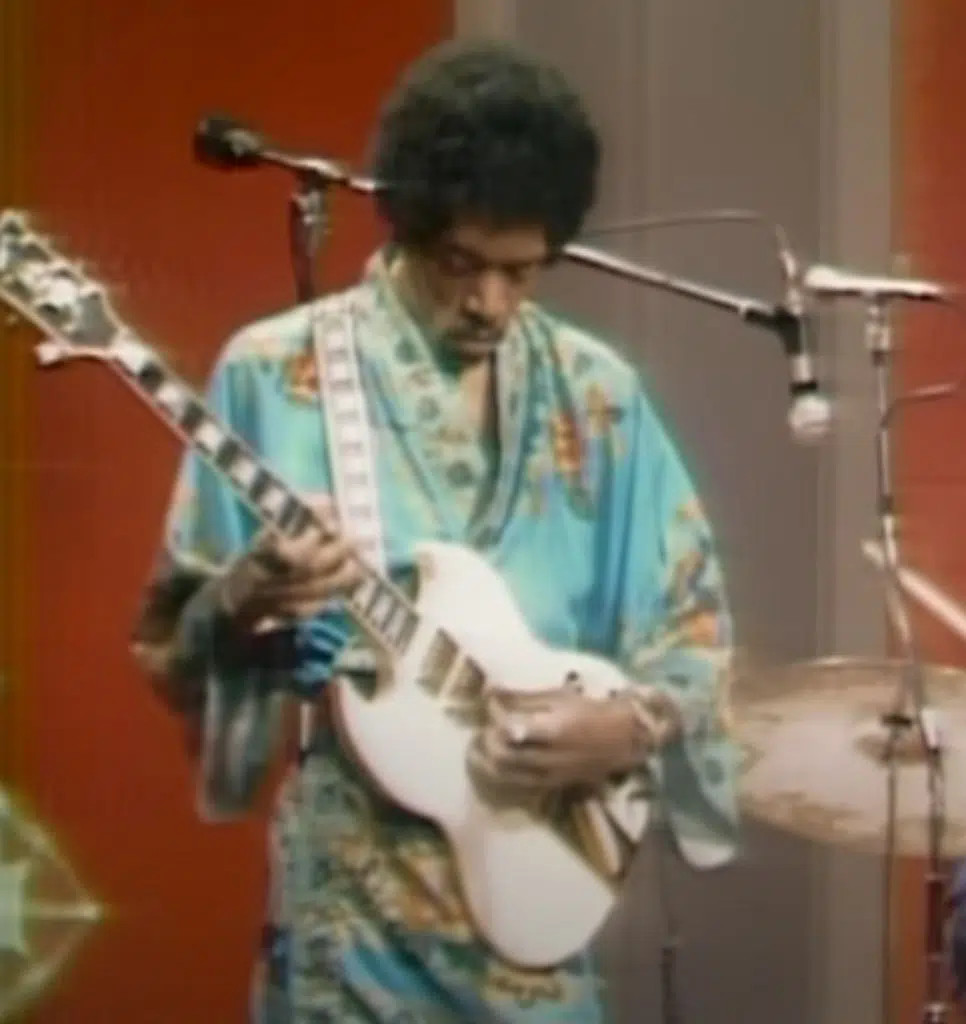 Jimi playing his Custom SG on the Dick Cavett show in 1969.
Jimi playing his Custom SG on the Dick Cavett show in 1969.
1970 Gibson Left-Handed Flying V: Custom-Made for a Legend
A 1970 Gibson Left-Handed Flying V was custom-built for Jimi Hendrix in the spring of 1970. He played it until his untimely death, most notably at the Isle of Wight Festival in August 1970. While largely a standard Flying V, it incorporated unique custom features for Hendrix, including split diamond inlays, a fully bound neck, a Les Paul Custom truss rod cover, and an inlaid Gibson logo on the headstock. This final custom-made guitar is now exhibited at the Hard Rock Cafe in London, England.
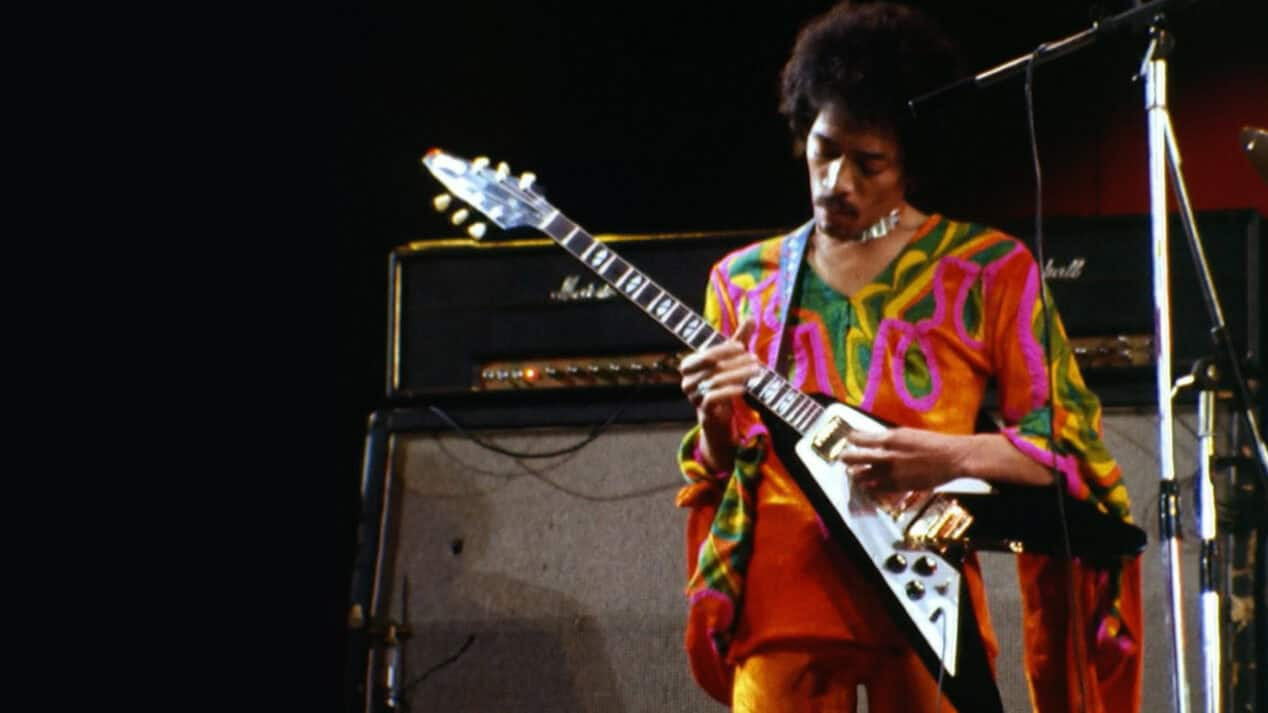 Hendrix playing his Flying V at the Isle of Wight Festival, 1970. Credit: Chris Walter
Hendrix playing his Flying V at the Isle of Wight Festival, 1970. Credit: Chris Walter
Jimi Hendrix’s Guitar Legacy: More Than Just a Strat
Jimi Hendrix’s brief but incandescent career cemented his status as a guitar revolutionary and an enduring icon for generations of musicians. His profound influence on guitar playing makes his instrument choices a subject of perpetual fascination. While the Stratocaster remains his most iconic association, Jimi Hendrix’s guitar journey reveals a true guitar enthusiast, constantly exploring new sounds and instrument types. Whether you’re a Stratocaster devotee or drawn to more unconventional guitars, remember Hendrix’s spirit of sonic exploration. Grab your guitar, equip it with Stringjoys to unleash its full potential, and let your own musical voice resonate. And maybe, just maybe, keep the lighter fluid for another occasion.


